| Lot |
Photo |
Description |
Lot 1094 |
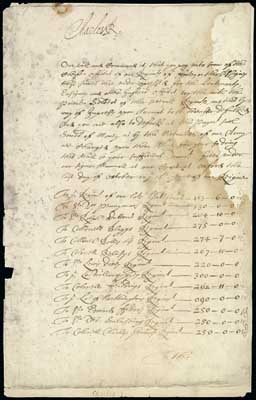 |
Charles I (1600-1649), British Monarch, King of England, King of Scotland, and King of Ireland (1625-1649), executed. Manuscript Document Signed "Charles R", two pages (with two blank integral leaves), 8 x 12, Court at Oxford, October 31, 1642 (18th year of his Reign). To Matthew Bradly, Paymaster General of the Army, authorizing payments to some of the "Cheife Officers of our Regimts of Foote or their Assignes these sum(m)es here under expressed & for the Lieutenants, Ensignes and other Inferior Officers together with the private Soldiers of their several Regimts…" Fine clear signature. Document stained, pages mainly separated and reinforced as well as other splitting and restoration. Very Good condition.
Estimate 1,000 - 1,500
AN IMPORTANT DOCUMENT ISSUED JUST SIX DAYS AFTER THE OUTBREAK OF THE CIVIL WAR AND RELATING TO THE ORGANIZATION OF AN ARMY WHICH LACKED PROPER FUNDING, HAVING BEEN FORMED UNDER AN OUTDATED SYSTEM.
Following his attempted manhandling of Parliament culminating in armed force, Charles had only recently moved his Court to Oxford. His defeat by Oliver Cromwell and the Roundheads, who drew their base of support from more affluent London and southern and eastern counties with their emerging middle class, led to his imprisonment and eventual execution for treason.
View details and enlarged photo
|
Lot 1095 |
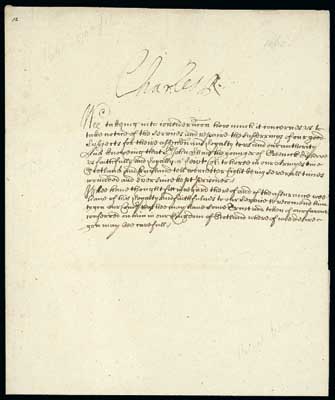 |
Charles II (1630-1685), British Monarch, King of England, King of Scots, and King of Ireland (1660-1685). Manuscript Document Signed"Charles R", one page (with blank integral leaf), 7¼ x 11½ no place, undated (probably circa 1660, after the Restoration). Royal Warrant and Letter of Recommendation to rectify the situation of Sir John Shaw the younger of Greenock, who loyally served the Army in Scotland and England, having been wounded at Worcester and since held prisoner.
"Wee takeing into consideracon how much it concernes us to take notice of the services and repaire the sufferrings of our good Subjects for theire affecc[i]on and Loyalty to us and our authority And knoweing that Sr. John Shaw the youger of Greenock did serve us faithfully and Loyally as Leiut' Col: to horse in our Armyes in Scotland and England tell Worcester fight being severall times wounded and ever since kept prisoner.
"Wee have thought fitt in regard thereof and of the assurance wee have of his Loyalty and faithfulnes to our Service to recomend him to you our Concrs. that hee may have some Trust and token of our favour conferred on him in our Kingdom of Scotland whereof wee desire you may bee carefull."
Very Fine signature and document.
Estimate 1,000 - 1,500
Charles II spent two significant periods in Europe, having first fled England after his father's execution in 1649, and then once again after his unsuccessful invasion of England in 1651, when he was defeated by Cromwell at the Battle of Worcester (reference to which is made in the above letter). In 1660, he was invited to return to England by the newly elected House of Parliament.
View details and enlarged photo
|
Lot 1096 |
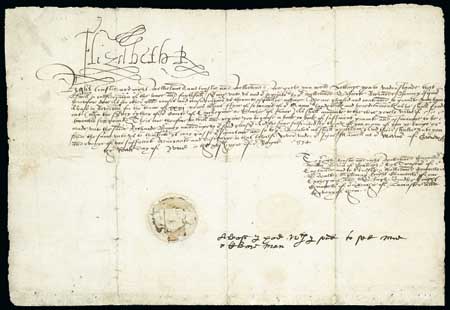 |
Elizabeth I (1533-1603), Queen of England and Queen of Ireland (1558-1603), daughter of Henry VIII and last of Tudor line of monarchs. Manuscript Document Signed "Elizabeth R", one page (with partial blank leaf docketed), 12 x 8¼ Greenwich, June 1, 1574 (16th Year of Reign). Royal Warrant for lease of land in Severton to the value of £26 annually for twenty-six years to Richard Bunney of Seymour. Full text reads:
"Right trusty and right wellbeloved and trusty and wellbeloved we greet you well. Letting you to understand that as well in consideration of the long and faithful service unto us and our parents by our wellbeloved subject Richard Bunney of Seymour heretofore done as for othr good causes and considerations us thereunto especially moving, we are pleased and contented to grant unto him a lease in Severton for the term of xxxi years without fine [end] of so many of our manors, lands, ten[an]ts, and hereditaments as he shall find out (within the survey either of our court of exchequer or duchy of Lanc[aste]r) as shall amount to the clear yearly value of twenty-six pounds. They are therefore to will and remit you to cause a book or books of sufficient grant and assurance to be made unto the said Richard Bunney accoring to our said pleasure. And the sum subscribed by the hand of you or any of you, you bring or send the same unto us to the intention [that] it may pass our signature and so to our seals as shall appurtain. And there shall be unto you and every of you sufficient warrant and distraint in that behalf.
"Given under our manual sign at our manor of Greenwich, the first day of June in the xvi year of our reign. 1574.
"To our right trusty and right wellbeloved chancellor Will[ia]m Baron of Burleigh o[u]r high Treasurer of Englande and to o[u]r trusty and wellbeloved chancellor Walter Myldmay knight Chancellor of our Exchequer and Sir Ra[l]ph Sadler knight chancellor of o[u]r Duchy of Lancaster and to every of them."
Bold sharply-written distinctive signature, just crossed by fold, wafer seal (more than half still remaining) applied through the second leaf of document, which has been rejoined to the front page, document folded in eighths. Fresh state of preservation for such a document. Enclosed in custom quarter-leather portfolio.
Estimate 15,000 - 20,000
A MAGNIFICENT EXAMPLE OF THE SIGNATURE OF ONE OF THE MOST INFLUENTIAL AND LEGENDARY LEADERS IN WORLD HISTORY— THE MONARCH WHO TRANSFORMED ENGLAND INTO A TRUE WORLD POWER.
View details and enlarged photo
|
Lot 1097 |
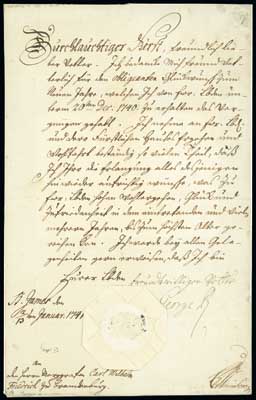 |
George II, George Augustus (1683-1760), British Monarch, King of Great Britain and Ireland (1727-1760), Duke of Brunswick-Lüneburg, Arch-Treasurer and Prince-Elector of the Holy Roman Empire. Letter Signed "freundwilliger Fetter" (Your most obliging Cousin) "George R", one page, 8 x 12¾. From St. James, January 13, 1741. To Herren Markgraf Carl Wilhelm Friedrich zu Brandenburg, Ansback, Bavaria, thanking him for his New Year's greetings. In German. Very Fine intact wafer seal (a few letters have black ink), address leaf panel cut out from another leaf and neatly pasted on reverse. Very Fine.
Estimate 1,000 - 1,500
A member of the House of Hanover, George was the last British monarch born outside Great Britain. He was related to Carl Wilhelm Friedrick of Brandenburg through his marriage to Markgraf Caroline of Brandenburg-Ansback, to whom he was not only devoted, but also relied upon to run his Court and assist in politics.
View details and enlarged photo
|
Lot 1098 |
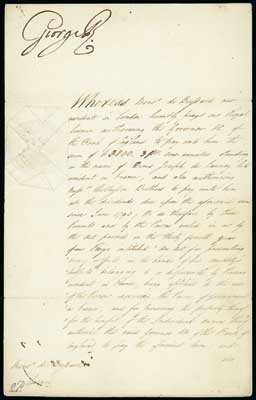 |
George Iii, George William (1738-1820), British Monarch, King of Great Britain and Ireland (1760-1801), King of the United Kingdom and Ireland (1801-1820), Manuscript Document Signed "George R" and "Portland" (3rd Duke of Portland, Home Secretary), two pages (with blank integral leaf), 7¾ x 12¼ Court at St. James, March 28, 1796. To Mr. Bortsard authorizing the Governor of the Bank of England to pay monies to him, since special permission was needed to remit money to foreign subjects. Intact wafer seal. Bold signature. Minor splitting along folds, Very Fine.
Estimate 1,000 - 1,500
When he came to the throne, King George III attempted to revive the power which the monarchy had lost to the ministerial council under his father and grandfather. Whatever gains he had made in this regard were, however, nullified by his fluctuating mental state and disastrous policy toward the American Colonies, especially with the defeat in the American Revolution.
View details and enlarged photo
|
Lot 1099 |
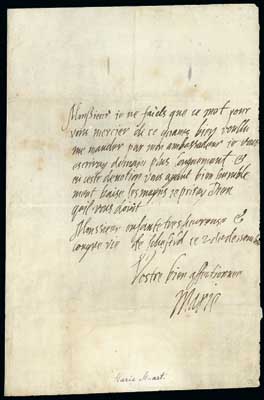 |
Mary I, Mary Stuart, also known as Mary, Queen of Scots (1542-1587), Scottish Monarch (1542-1587), Consort of France (1559-1560). Autograph Letter Signed "Vostre bien affectionée Marie", one page, 8 x 12¼ Sheffield (Castle), December 2 (1581). Evidence points to Henry III, King of France, as the recipient. In French, the letter translates:
"Monsieur, I write only this word to thank you for the good wishes sent me by my ambassador, and I shall write tomorrow at greater length, and, holding you in great devotion, most humbly kiss your hands, praying to God that he may keep you, Monsieur, in the best health through a long life.
From Sheffield, the 2nd December
Your most affectionate Marie"
Very Good condition, boldy penned, light soiling.
Estimate 25,000 - 30,000
OF GREAT HISTORICAL INTEREST AND IMPORTANCE. A MOST POIGNANT AND EXTREMELY RARE PERSONAL LETTER WRITTEN FROM PRISON.
Mary Stuart was the daughter of James V, King of Scotland, who died when she was six days old, thus making her Queen of Scotland. As the great-granddaughter of Henry VII of England, she was also an heir to the English throne after Henry VIII's children. Following the breaking off of her engagement to Henry VIII's son, which would have united the two thrones, Mary was sent to France in 1558, where she married the Dauphin, who became King Francis II a year later. Following his death in 1560, she returned to what was now Protestant Scotland, but her Catholicism was tolerated. Her marriage to her murderously ambitious second cousin, Henry Stuart (Lord Darnley) in 1565 lasted only two years, as he himself was the victim of murder. Mary's controversial marriage to the acquitted chief murder suspect, James Hepburn, 4th Earl of Bothwell, only served to unite the fractious nobles who were victorious at Carberry Hill without any battle having been fought. Following her abdication in favor of her son and her escape, she again raised an army, which also was defeated, finally seeking refuge with Queen Elizabeth, who had Mary imprisoned for the rest of her life. Always seen as a threat to Elizabeth's throne, especially with her claim through her late Stuart husband, Lord Darnley, who had been next in line for succession to the throne after Elizabeth I, Mary was eventually executed in 1587. The son she had with Darnley, James V, of Scotland, eventually became King James I of England.
In reference to the December 2 letter above, there is a letter written to Henry III a day later, which contains the details she alludes to in her first letter. In the December 3 letter, she asks Henry to remember the rights and titles she held in France, which Charles IX had also confirmed. According to detailed scholarship, the terminology used in both letters is so similar as to leave no doubt that the December 2 letter was also written to Henry III. For example, Henry III is addressed simply as "Monsieur" without any allusion to title or position, and Mary signs her name plainly "Marie" and not "Marie R." The highly personal and affectionate end greeting and use of the phrase mentioning the kissing of hands would not have been used toward someone of a lower rank. Correspondence between Mary and Henry III was sent through ambassadors, and it was also prudent not to mention titles for fear that letters might be intercepted by the English.
View details and enlarged photo
|
Lot 1100 |
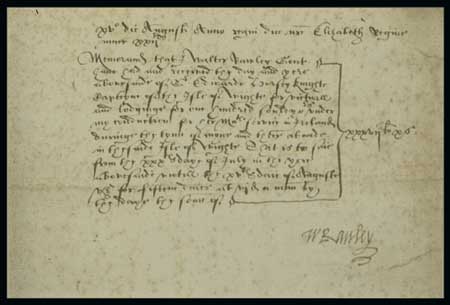 |
Raleigh, Sir Walter (1552-1618), English writer, poet, courtier to Queen Elizabeth I, and explorer who sponsored the first English colony in the New World. Autograph Document Signed "W. Rawley", one page "7¼ x 4¼", no place, August 15, 1580. Receipt for £37/10/- for troops expenses in Ireland. The Latin text reads:
"xv day of August in the twenty-second year of the reign of Elizabeth the Queen"
"Memorandum that Walter Rawley Gent. have had and received the day and year abovesaid of Sir Edward--Knight--of the Isle of Wight for victual and lodging for one hundred soldiers under my conduction for her Majesty's service in Ireland during the time of mine and their abode[?] in the said Isle of Wight that is to say from the xxxth day of July in the year abovesaid until the xvth day of August for fifteen days…xxx onto xv…W. Rawley"
Fine state of conservation, small tear at lower right clear of signature and light age spotting, with engraved portrait by C. Picart. In ornate frame 22¼ x 16.
Estimate 30,000 - 40,000
Regarded by many as the most colorful personality of the Renaissance, Raleigh landed in Cork in the summer of 1580 and served as a captain of a company of foot in Munster, where he played an active role in the suppression of the Rebellion of the Desmonds. He was also involved in the siege of Smerwick, when 700 Italian and Spanish soldiers who had surrendered were nevertheless massacred. Following this ruthless victory in Ireland, Raleigh was given 40,000 acres of land in Munster, which made him one of its principal landowners. After his return to England in late 1581, Raleigh used his charm and wit at court to become one of Queen Elizabeth I's favorites.
Raleigh first sailed to the New World in 1578 with his half-brother Sir Humphrey Gilbert. Using funding from his private purse and those of friends, he established the first English colony in America on Roanoke Inland in 1584, which ended in failure. His second attempt three years later was doomed to the same fate. All the settlers disappeared under unknown circumstances, and their whereabouts were never discovered.
There were numerous spellings of Sir Walter Raleigh's name. For example, with Sir Robert Cecil, later the 1st Earl of Salisbury, one encounters three different variants: Rawley, Raleigh, and Ralegh, while to King James, who ordered his execution, he was Raulie and Raleigh. When writing his wife, he was Ralegh. With Henry Howard it was Rawlegh and Rawlie. Rawlighe appears in correspondence with the Lord Admiral, while it is Rawlye to Lord Cobham. Interestingly, he never himself used the name Raleigh, and from 1584 he signed "Ralegh".
View details and enlarged photo
|
Lot 1101 |
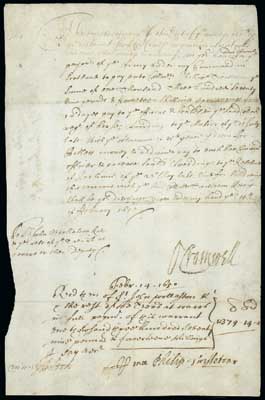 |
Cromwell, Oliver (1599-1658), English military and political leader responsible for transforming England into a republic, Lord Protector of the Commonwealth of England (1653-1658). Manuscript Document Singed "O Cromwell", one page, 7¾ x 11¼ February 14, 1650. To Sir John Bookaston Knight concerning payment to regiment under Philippe Troistoson and the Army in Scotland, receipted annotation at bottom signed by Philip Twistleton. Bold signature (minor ink speckling), folded in thirds. Fine for such an old document.
Estimate 6,000 - 8,000
After the execution of Charles I in 1649, Cromwell turned his attention to quelling various rebellions. In Ireland this was accomplished with incredible brutality, after which he turned his attention to Scotland. When the Scots proclaimed Charles II as King in February, 1649, Cromwell decided to invade Scotland in 1650, and by 1653 he had secured political control of the British Isles and became Lord Protector of the Commonwealth of England, which comprised England, Scotland, and Ireland.
Philip Twistleton was later to become Commissioner of Scotland (in the name of the Parliament of England) in 1660 during the three month period between May and August coinciding with the Restoration.
View details and enlarged photo
|
|